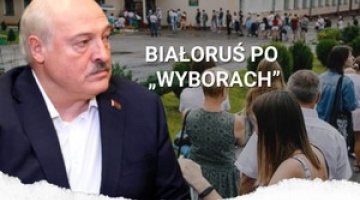Belarus: poor public response to Tsikhanouskaya’s ultimatum
On 25 October, opponents of Alyaksandr Lukashenka held another nationwide protest action. This time the demonstrations were held under the slogan of ‘The National Ultimatum’, referring to the demands put forward on 13 October by Sviatlana Tsikhanouskaya that the president resign, political prisoners be released and violence halted. The deadline to implement these demands expired on 25 October, and so the Sunday demonstrations took the form of public pressure on the regime. As usual, the largest demonstration took place in Minsk, where the number of participants exceeded 100,000, a reversal of the downward trend that had been observed since September (only around 50,000 people gathered last Sunday). However, people in the regions demonstrated on a much smaller scale than in the capital (around 2000 protesters took to the streets in Brest and Grodno, and several hundred in Vitebsk, and only a few dozen in Navahrudak, Vaukavysk, Lida, Navapolatsk, Babruysk, Pinsk and Barysau); nevertheless, this still represents a rise in the number of participants and an expansion in the number of towns where protests were held.
The security forces in Minsk refrained from breaking up the demonstration head-on, at first confining themselves to blocking the streets. At the end of the march, however, a large number of stun grenades and rubber bullets were used, and after the demonstrations were dispersed into smaller groups, individual demonstrators were caught and detained. The militia took more decisive action in the provinces as the protests were less numerous (for example, tear gas was used in Lida). In total, over 500 people were detained throughout the country, some of whom were severely beaten and injured.
Despite the preparations and the still high level of social discontent, Tsikhanouskaya’s appeal for a general strike and road blockade as of 26 October did not bring the expected results. Only some individual factories made attempts to organise a strike (including the MTZ tractor works, the MAZ automotive works, and the MZKT armaments works in Minsk, as well as electrotechnical plants and the Azot nitrogen plant in Hrodna), but there are no confirmed reports of production being completely halted in any of the plants. The protesters in the state-owned industries were joined by employees of some private companies from the catering, telecommunications, IT and service sectors. Students in Minsk made very active attempts to paralyse the work of their universities; they then joined a combined street protest by an anti-government march of retirees. In total several thousand people participated in this demonstration. The police reacted brutally to Monday’s strike action. The student demonstrations and the few chains of solidarity were dispersed, and their participants were then arrested. Meanwhile, modest attempts by pedestrians and drivers to block the roads were met with almost immediate interventions by the traffic police. The few attempts to block roads and streets in cities, mainly in the early morning hours, also ended in failure. Workers calling for strikes were also detained (around 100 people were detained at the Azot plant in Grodno, which has been known for its pro-opposition sentiments).
On 22 October Sergei Naryshkin, the head of the Russian Foreign Intelligence Service, paid a visit to Minsk, formally in order to attend consultations between the Belarusian and Russian KGB and SVR (foreign intelligence services). He was primarily meeting President Lukashenka to discuss the issue of the constitutional reforms being prepared by the Belarusian government. Naryshkin stated that the reform was an adequate response to the Belarusian public’s expectations. However, the government in Belarus is still pretending to draw up draft amendments to the constitution. To this end, debates are being held in regional cities, mainly with the participation of pro-government experts and social organisations. At the same time, the regime is gradually relaxing the rules of isolation for some of its political prisoners; for example Lilia Ulasava, a member of the presidium of the opposition Coordination Council, and the political consultant Vitali Shklarau have been released from house arrest.
On 24 October, US Secretary of State Mike Pompeo held a telephone conversation with Lukashenka. Interpretations regarding the course and content of this call differ significantly. Western news agencies, citing sources in Washington, reported that the topics discussed included dialogue between the government and the public, democratisation and the Belarusian authorities’ consent for Shklarau (who has US citizenship) to leave the country. As Minsk sees it, the head of American diplomacy declared his continued support for Belarusian sovereignty and his readiness to develop cooperation between the two countries.
Commentary
- The intensification of the protests in Minsk and the revival of public activity in the regions partly result from the actions of Tsikhanouskaya, who repeatedly called on Belarusians to demonstrate their support on 25 October for the idea of a national ultimatum against Lukashenka. The rise in civic activity also indicates that the level of social discontent is still high, and is persisting despite fatigue at the two-and-a-half-month-long political crisis.
- The course of the protests related to the ultimatum against the regime so far shows that organising a blockade of the entire country is a difficult task, exceeding the possibilities of the Tsikhanouskaya-led opposition. Working-class groups have shown less interest in participating in the strikes than they did in August (when the movement against Lukashenka had the greatest potential), although even then none of the most important plants experienced a complete suspension of production or sit-in strikes. At present, then, we should not expect the protests to escalate any further. The small number of roadblocks shows that most of the rebellious citizens are still not ready for open, revolutionary confrontation with the forces of law and order. The failure of the first day of the nationwide strike action has weakened Tsikhanouskaya’s authority.
- The regime is continuing the tactic of avoiding the pacification of mass demonstrations, while not hesitating to use violence against smaller groups, especially in the provinces, which had been considered under control just a few days ago. This is also confirmed by the actions the security forces took against the smaller-scale demonstrations on 26 October, which were aimed at nipping any attempts to organise a general strike in the bud.
- The government is conducting a sham public debate on constitutional reform and has released some political prisoners from house arrest, in order to show their alleged willingness to engage in dialogue with its citizens. Moscow also expects Minsk to undertake such actions, which the visit by Naryshkin may have confirmed. The Kremlin hopes that the declared constitutional reforms will at least partially de-escalate the conflict between the regime and the rebellious part of the public, and at the same time weaken the position of the Belarusian president.




